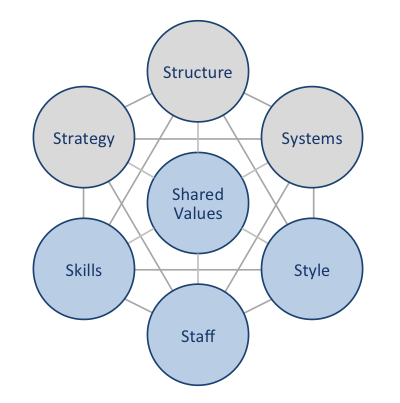Walmart McKinsey 7S Model
Walmart McKinsey 7S framework illustrates the ways in which seven elements of businesses can be aligned to increase effectiveness. According to the framework strategy, structure and systems represent hard elements, whereas shared values, skills, style and staff are soft elements. McKinsey 7S framework stresses the presence of strong links between elements in a way that a change in one element causes changes in others. As it is illustrated in Figure 10 below, shared values are positioned at the core of Walmart McKinsey 7S framework, since shared values guide employee behavior with implications in their performance.
Hard Elements
Strategy. Walmart pursues cost leadership business strategy according to its brand promise of ‘everyday low prices’. The company has been able to sustain this strategy thanks to the economies of scale, exercise of its vast bargaining power to secure low prices from suppliers and paying employees low wages. Three important pillars in Walmart business strategy can be specified as – assortment, price and access. Due to its aggressive pursuit of cost leadership strategy, Walmart has attracted criticism for paying its employees low wages with a consequent negative impact on the quality of customer services. CEO Doug McMillion had to address this issue via introducing certain changes in Walmart business strategy. Specifically, in February 2015, the company announced a USD1 billion investment in U.S. hourly associates to provide higher wages, more training and increased opportunities to build a career with Walmart.[1]
Structure. Traditionally, Walmart organizational structure has been highly hierarchical due to the massive size and scope its business that comprises more than 11,000 stores in 27 countries and serves nearly 260 million customers each week under 72 banners.[2] However, new CEO Doug McMillion introduced initiatives to delayer the organizational structure. Specifically, in 2015 Walmart announced that “it will eliminate a layer of management inside its 4,500 U.S. stores to reduce bureaucracy, improve customer service, and give front-line workers more input into how their section of the store is run”[3].
Systems. There are wide range of systems of varying level of complexity that facilitate Walmart business operations. These include but not limited to employee selection and recruitment, IT, finance and employee performance appraisal and others…
Walmart Stores Inc. Report contains a detailed discussion of Walmart McKinsey 7S framework. The report also illustrates the application of the major analytical strategic frameworks in business studies such as SWOT, PESTEL, Porter’s Five Forces, Value Chain analysis and on Walmart. Moreover, the report contains analysis of Walmart’s marketing strategy, leadership and organizational structure and discusses the issues of corporate social responsibility.
[1] Annual Report (2015) Walmart Stores Inc.
[2] Annual Report (2015) Walmart Stores Inc.
[3] Wahba, P. (2015) “Wal-Mart to shed some in-store management in bid to improve shopper service” Fortune, Available at: http://fortune.com/2015/04/17/walmart-management-cuts/


